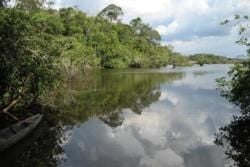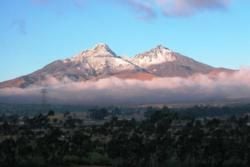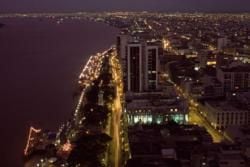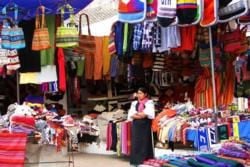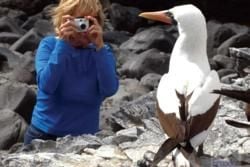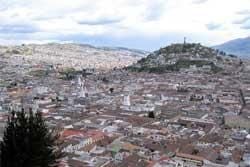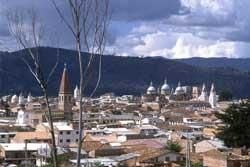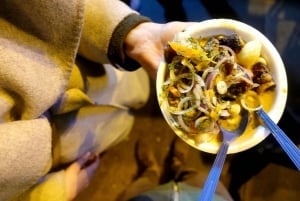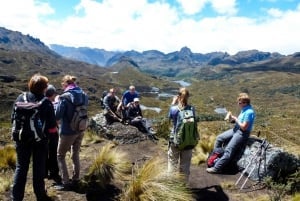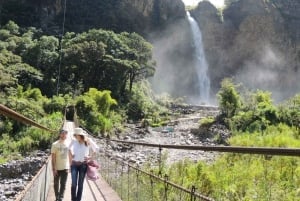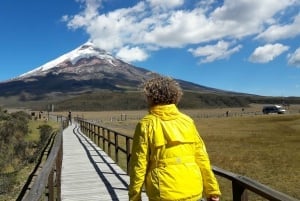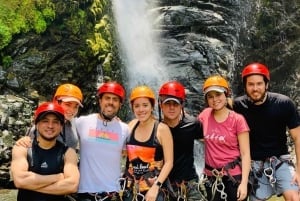Top Ten Attractions in Ecuador
Choosing a Country’s "Top Ten" main attractions, those that one "must" see and/or do is not an easy task. And it becomes even more complex in a nation like Ecuador, known for its amazing variety of geographic, scenic, historic, cultural, nature or dozens of other types of attractions, many of them unique in the world, and well worth visiting.
So, after considerable debate and many cups of coffee, we have come up with a list. Some of the chosen places are generic, others more specific, but all are real "musts". To avoid the eventually subjective ranking in order of importance, we decided to present them to you alphabetically. So here they are.
Amazon Region
Ecuador is privileged to have the most easily accessible portion of the immense Amazon basin. Thirty minutes by airplane or a few hours by road bring travelers from the capital city of Quito to one of the planet’s globally recognized "hot spots of biodiversity". Dozens of options for lodging and touring, allow you to come into close contact with a fabulous wonderland, where the days feature stunning fauna and flora encounters; sharing the culture and ways of life of the ancestral indigenous communities who have had the rainforest as their home for centuries; exploring lakes and waterways, observing myriads of colorful birds, paddling slowly along small creeks, watching the antics of several species of monkeys, swimming or just enjoying a magic sunset with a refreshing cocktail in hand.
Avenue of the Volcanoes
The Andean mountains cross Ecuador from north to south, from the Colombian border all the way to the Peruvian frontier. Two parallel ranges, face each other, just separated by a long carpet of verdant valleys, ranging from 2.500 to over 12.000 feet above sea level. Highlights of this region of Ecuador are the more than 20 volcanoes, many of them active and many covered with glaciers and snows, at well above 17.000 feet of elevation. Alexander von Humboldt, when exploring Ecuador extensively in the 19th century, called this part of the country an "Avenue of Volcanoes". World Heritage Cities and Sites; small and picturesque villages; ancestral Indigenous markets; creative handicrafts, rich folklore and delicious gastronomy compete with the beauty of the mountainous countryside, the awesome volcanoes, the fertile valleys and endless hills, cultivated in terraces, which are the frame for many lodging options, on colonial haciendas, historic estates or charming country inns, your home-base for cultural experiences, horseback rides, treks, fascinating train rides or biking.
Baños
The Spanish word stands for "Baths". For decades, this has been Ecuador’s most popular Thermal Springs Resort. Nestled on a bowl-shaped narrow valley, surrounded by stunning Andean scenery and under the shadow of one of the major volcanoes, the Tungurahua, Baños, quaint and very picturesque, lures visitors to its many public and private thermal baths and pools. At least two international-level Spas are now also available. The city is also known as the "Gateway to Amazonia". A one hour’s bus or car ride can bring you to the Amazonian rainforests, passing by endless cascades, deep river gorges and canyons. The stunning and irregular topography has led to convert Baños also into a major hub for adventure sports and activities, such as river rafting, tubing, mountain biking, cannoning, vertical rock climbing or descending, canopying and a host of other high adrenaline sports. An abundant offer of lodgings for all tastes and budgets and a host of local operators will offer visitors a wide range of activities. Not to be forgotten are the local handicrafts and artisanal sweets. Baños has become very popular with young crowds of national and international visitors, who certainly have plenty of bars, discos, karaoke and entertainment to swing the night away…
Cuenca
Cuenca is a beautiful colonial city in the south of the Andean Region, a UNESCO World Heritage Site and home to some of Ecuador’s finest handicrafts. The city is surrounded by hills and mountains, crossed by four rivers and its Historic Center fascinates the visitors with its dozens of colonial churches, convents, plazas, cobble-stoned streets and a charming Spanish architecture. The third largest and most important city of Ecuador, it harmoniously blends or separates, where necessary, the old and romantic, from the modern and bustling tempo and styles. Reachable by air in forty minutes from Quito or 25 minutes from Guayaquil; its road accesses are equally good and easy, with great scenery along the way. A renowned center of culture and arts and home to exquisite gastronomy, Cuenca offers a wide range of Hotels and lodging options, from international-class hotels, sophisticated Boutique Hotels on beautifully restored colonial mansions or smaller hostels for all budgets. Here you can find some finest quality handicrafts: the world-famous "Panama hats", hand-woven from a palm-tree’s straw; Pre-Columbian-inspired designs, hand-knitted or embroidered on classy garments; superb gold and silver jewelry and more. The Inca Fortress of Ingapirca; the lovely valleys and towns of Gualaceo, Paute and Chordeleg, or the amazing lagoon’s complex of El Cajas National Park, are all within a one-hour’s ride from Cuenca, a city that for three consecutive years has been designated by prestigious specialized publications, as the "World’s Best place to live for retirees".
Galapagos Islands
Ecuador’s tourism and nature "Crown Jewel", the islands, first natural area to be declared by UNESCO a World Heritage Site, back in 1979, are located in the Pacific Ocean, 600 miles from the coast of Ecuador, country to whom they belong. Renowned for their unique wildlife, dramatic landscapes and unafraid animals, is also the cradle of Charles Darwin’s theories of evolution and natural selection. The Archipelago is definitely a "must" for scientists, naturalists or nature-loving tourists. The days here feature encounters with centenary giant tortoises; marine and land iguanas; blue or red-footed boobies; flamingos along with penguins; flightless cormorants and frolicking sea lions, just a small sample of the many unique fauna species to be found there. The underwater world is equally fantastic and the Galapagos Marine Reserve, second largest in the world and also a UNESCO World Heritage Site, is the venue for superb swimming, snorkeling, scuba diving and other authorized aquatic activities. Tightly controlled and regulated to ensure the preservation of such unique but also fragile ecosystems, Galapagos offers dozens of alternatives to visit, from first class cruise-ships with a maximum capacity of 100 passengers each, to mid-size luxury yachts, exclusive catamarans, small motor and sailing boats; as well as by scores of land-based programs on the few inhabited islands, with luxury eco-hotels or small hostels, combined with small day-trip boats and a myriad exploration options and activities, both on land and in the water.
Guayaquil
The country’s largest city and main river and sea-port, located between the western shores of the huge Guayas River and a large network of mangrove-lined waterways, deriving from the Gulf of Guayaquil; boasts a modern Waterfront, teeming with activities and features: a botanical garden, monuments, children playgrounds, an Imax theater, museums, a marina and a host of eateries and small shops. Here we find the old Moorish-style Clock Tower and the Memorial complex which recreates the historic meeting of South America’s Liberators during the Independence: Simon Bolivar and San Martin. The regenerated colonial center, the extremely colorful neighborhoods of Las Peñas and the Santa Ana Hill are definitely not-to-be-missed attractions. The Park of the Iguanas, framed by the city’s neo-gothic Cathedral and the colonial churches of San Francisco, La Merced and Santo Domingo are also city icons. There is also a vibrantly modern Guayaquil with ample avenues, five-star hotels, financial and commercial centers, great shopping malls and one of the best Airport Terminals in Latin America. Culture here has plenty of spaces and activities, while the local gastronomy reaches high quality heights at most of the city’s restaurants. And, as a good port city, Guayaquil is well alive at night with plenty of bars, discotheques and lots of entertainment for those who enjoy night life.
Imbabura Province
Just one hour and a half north of the capital city, along a first-class highway, the province of Imbabura offers a magnificent blend of nature and culture. Its main attractions include the fabulously scenic lakes of San Pablo, Cuicocha and Yahuarcocha, as well as the Imbabura and Cotacachi Volcanoes and their surrounding Andean scenery. This is the home of the Otavalo indigenous peoples, who for centuries have developed a superb skill as weavers of sheep’s, alpaca and llama wools, turning the materials into colorful garments like shawls, ponchos, scarves, tapestries and many other objects either for practical use or for decoration. The Otavalo Ponchos Market is considered one of South America’s most colorful and popular with visitors. Other handicrafts from the area include fine wood-carvings, felt hats, jewelry and embroidery. The Cotacachi-Cayapas Ecological Reserve begins at the foothills of the Cotacachi Volcano, with its mythical Cuicocha crater-lake, a place of unique wildlife. The town of Cotacachi is home to some of Ecuador’s finest leather goods and has acquired international fame for the quality of its products. Ibarra, the provincial capital city is known as Ecuador’s "White City" and is simply charming with its colonial architecture, cobble-stoned streets and nicely-gardened plazas and courtyards. Some of Ecuador’s finest colonial Haciendas, now converted into posh country Hotels, are part of the varied lodging alternatives available to explore and enjoy this natural and cultural gem of Ecuador.
Machalilla National Park
Located on the central Pacific coast of Ecuador, Machalilla boasts pristine beaches, unique dry-tropical forests’ fauna and flora, ancient Pre-Columbian archaeological sites, museums and water activities. It has become the main center of operations, between May and October, for the "whale watching season"; when hundreds of Humpback whales from Antarctic waters migrate to the warmer Equatorial waters to court, mate and raise their calves. The observation of these gigantic but gentle leviathans has become one of the most popular activities in this area. The traditional coastal gastronomy, based on fish, sea-food and plantain is second to none. Los Frailes is considered by many as Ecuador’s most beautiful beach. A year-round highlight of the Park is the stunning La Plata Island, located sixteen miles off-shore, and known as "little Galapagos", since its fauna includes some of the birds found in Galapagos: blue-footed boobies, frigate birds, as well as small sea-lion colonies. Swimming, snorkeling and scuba diving are top-notch around the solitary rocky island. The picturesque town of Puerto Lopez, tucked around a crescent-shaped bay is the hub for fishing and tourist boats which add color to the bay. A variety of hotels of all kinds are available to choose from.
Mindo
One and a half hours’ drive, northwest of Quito, towards the coastal plains, the Mindo-Nambillo Cloud Forest and Reserve is part of the Chocó Bio-region one of the world’s most rich and diverse in fauna and flora. The area has become one of the most popular bird-watching paradises for dedicated or amateur "birding" buffs. The proximity to Quito even allows for day-excursions, yet it is best to spare at least two days and one night in the area. Among the birdlife to be found, dozens of species of the most amazing hummingbirds can be seen. With brilliant metallic colors and varied sizes and shapes of beaks, these birds are the main attraction. However, the area has much more: colorful tanagers, toucans, parakeets, woodpeckers or trogons are just some of the species to be found. An icon bird of the area is the somewhat elusive but truly spectacular, brilliant red and conspicuously crested "cock of the rock". The Reserve is meandered by the Nambillo River and is also the venue for some river rafting activities, tubing, canopying and other adventure sports. Cascades, lush vegetation, rare orchids, brightly colored butterflies and occasional monkey sightings call for a great nature experience. As everywhere, the increasing demand of visitors has motivated the construction of a wide network of lodges, hotels, hostels, restaurants, guides’ and all kinds of tourism services’ suppliers.
Quito
Alphabetically last, but not least important, Quito, the historic capital city of Ecuador is, in fact, one of the country’s main tourism attractions and an absolute "must" for visitors in Ecuador. The city is rich with Pre-Columbian history, later it became the Inca Empire’s Northern capital and upon the Spanish conquest, it became the capital of the Royal Audience of Quito. During the 300-years of Spanish colonization, Quito became one of the most outstanding centers of art of the Americas, being called until present days as the "Florence of America". Spectacular churches, cathedrals, monasteries and convents guard an immense treasure of religious art: paintings, sculptures, ceilings and door-works. Such is the artistic wealth and the good state of preservation that UNESCO chose Quito as the very first city in the world to be declared a World Cultural Heritage Site. The city literally "crawls" up and down the hilly flanks of the imposing Pichincha Volcano and winds like a giant snake across a more than 30-miles’ long and narrow valley. It is surrounded by spectacular Andean scenery, with the stunning sight of the Cotopaxi, Cayambe and Antisana Volcanoes visible from many city angles. Old and new, colonial and ultra-modern, Quito is equipped with world-class hotels, superb national and international restaurants, theaters, museums, shopping malls and lively entertainment districts. The brand-new city’s International Airport, inaugurated on February 20th of 2013, is one of South America’s most modern, advanced and with one of the longest runways in the region. It has certainly set the city to jump into a whole New Era of development, while it dearly continues to preserve its glorious past and the enchantment of its Historic Center, also known as "the largest in surface and best preserved in Latin America".


